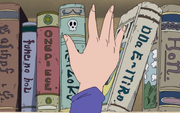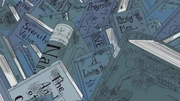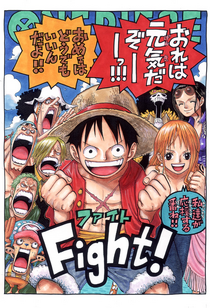Eiichiro Oda, born January 1, 1975 in Kumamoto City, Kumamoto Prefecture in Japan, is a Japanese Mangaka, best known as the creator of the "One Piece manga". He is married to Chiaki Inaba.
Early Life
As a child, Oda was inspired by Vikings and aspired to become amanga artist. He submitted a character named Pandaman for Yudetamago's classic wrestling manga Kinnikuman. Pandaman was not only used in a chapter of the manga but would also return as a recurring cameo character in Oda's own works. He is known to addEaster Eggs in his manga for fans to spot, including Doskoi Panda. Oda was inspired by the creator of Dr. Slump and Dragon Ball,Akira Toriyama. When he was young, he liked to play football at school and was nicknamed Odacchi by his friends. He would later voice Odacchi in the "Dream Football King!" short that was added to the third One Piece movie "Chopper's Kingdom on the Island of Strange Animals".
Manga career
Assistant Years (1992-1997)
In 1992, Oda at age 17 began his manga career starting as an assistant to three different mangakas for the weekly shonen manga magazine Shonen Jump. In the same year he submitted his first work called Wanted! for which he won second place at Tezuka Award. At first he worked with Masaya Tokuhiro on Jungle King Ta-Chan in 1992. In 1994, he briefly worked with Shinobu Kaitani with Suizan Police Gang before going back to Tokuhiro. In the same year he left college as a freshman. After Jungle King finished its run in 1995, he and Tokuhiro went on to create Mizu No Tomodachi Kappaman, it ran from 1995 to 1996. Also in the same year he moved on to work with Nobuhiro Watsuki on Rurouni Kenshin in 1996. During this time Oda met Hiroyuki Takei. Oda drew scenes in that manga with his own art style.
During 1993 and 1994, he created other works such as God's Gift for the Future (1993), Ikki Yako (1994) andMonsters (1994), the last of which he would later mix with One Piece.
In late 1996, while still working with Watsuki, he created two one-shots for the upcoming manga artist showcase called Romance Dawn, Version 1 and Version 2, which would become the first chapter of One Piece. In 1997, he later quit working with Nobuhiro to begin working on One Piece, doing many early One Piece sketches that would appear in Color Walk 1. He planned out the early stage of One Piece (chapters 1-8) before he officially started it.
However, he made many changes, such as changing Boogie to Buggy, changing Zoro from being Buggy's henchman to being a wandering swordsman, and changing Morgan's appearance (he was originally supposed to look like a Sumo but Oda's editors wanted him to change it, which he did). Later Nobuhiro Watsuki would pay a tribute to Oda by drawing the Straw Hat Pirates' jolly roger in one chapter of Rurouni Kenshin as a picture on a bomb used by Gein, one of Yukishiro Enishi'ssubordinates.
One Piece (1997-Current) Edit
Edit
Finally in August, 1997, he created his signature work, One Piece. Having been inspired by pirates, he made One Piece a pirate series.
In 1998, Oda did designs for the first OVA and was happy to see One Piece getting animated. In 1999, Toei Animation adopted One Piece and the staff would often meet up with Oda to discuss how to handle the series.
In 2002, he met Chiaki Inaba, who played Nami during the Shonen Jump Fiesta, and the two started going out, and in 2004, they got married. In 2006, he and his wife had a daughter. In April 2006, Oda unexpectedly fell ill and One Piece was not released that week. However he recovered and resumed One Piece the next week. Because of his recent illness, Oda felt the fans needed to catch up so he created Grand Line Times.
In 2007, at the JUMP Fiesta 2008, in the absence of Shūichi Ikeda, when the voice actors acted out the Red-Hair of Class 3 - Sea Time short, he wore a hot pink wig for the part and explained he would only do this because One Piece was in its tenth year.[1] Later that year, he teamed up with Akira Toriyama to create a Dragon Ball/One Piece crossover calledCross Epoch.
He was also involved in writing and directing the tenth One Piece movie, the first movie that he actually wrote the script for, in honor of the tenth anniversary of One Piece.
In 2011 after the Great Eastern Japan Earthquake disaster, Oda as well other mangaka drew messages to the victims.
Future Edit
Edit
Oda stated in an interview that he wanted to create a robot manga after he finished One Piece. Later, however, he stated that after he finishes One Piece, he would take the same path Toriyama did and create short-story manga.
Assistant credit
- Suizan Police Gang with Shinobu Kaitani (1994)
- Jungle King Ta-chan with Masaya Tokuhiro (1992–1995)
- Mizu no Tomodachi Kappaman with Masaya Tokuhiro (1995–1996)
- Rurouni Kenshin with Nobuhiro Watsuki (1996–1997)
Works
- Wanted! (1992)
- God's Gift for the Future (1993)
- Ikki Yako (1994)
- Monsters (1994)
- Romance Dawn, Version 1 (1996)
- Romance Dawn, Version 2 (1996)
- One Piece (1997–present)
Writer
Oda wrote the story for the tenth One Piece movie, Strong World, for the anime's 10th anniversary. This was the first time he wrote a script for any of the movies.
In Jump Festa 2011, Oda said that he would be directly involved in the production of the twelfth One Piece movie, which was released on December 15, 2012.
Cameos
- Voice of Odacchi in Dream Soccer King!.
- Played Shanks in the 2008 Jump Festa.[1]
- Name appeared on a book in Episode 70 (minute 18:08) as an Easter Egg and on the mirror in Episode 21 (minute 2:53).
- Oda's avatar (with the fish head on his head) is a support character in Gigant Battle and Gigant Battle 2: he draws a manga panel which traps opponents.
- Strangely, in a recent Japanese Fan Poll, Eiichiro Oda is currently ranked the 31st Most Popular Character in One Piece, despite the fact that he has never included himself in any issue of the manga (except the SBS).
 |
Odacchi in "Dream Soccer King!".
 |
Oda's name and "ONEPIECE" can be found on the spines of books in Episode 70.
 |
Another easter egg with Oda's name (upper left).
Working Method
Like many other mangaka, Eiichiro Oda uses his signature tools to draw his manga. To make sketches and starting steps of page-drawing, he uses (like many other artists around the world, not only mangaka) pencils in conjunction with erasers and an art gum eraser to fix errors. To ink the pages, Oda utilizes the G-Pen, Maru Pen and sharp refillable pens for inking. For making corrections after inking, he uses white ink.
To paint the color pages, Oda uses Copic markers, a brand of refillable color markers that several other mangaka use for that purpose. Although it was not confirmed, he has recently shown a tendency to use watercolors for painting, too.
Like many other manga artists, Oda seems to not use digital methods. This is a characteristic he shares with many mangaka, in terms of making a manga the most handcrafted as possible. That is something that non-Japanese artists do not often do, especially Americans and Europeans, who prefer the digital way of working over the traditional tools, for its easiness and high quality. Although is not confirmed, Oda does not seem to employ evident digital effects on his manga pages.
He commented in one of the first SBS sessions that he is usually a few (approximately 5) chapters farther along than the Shonen Jump ongoing chapters, having a difference of time between when a chapter is finished and sent to Shueisha to be published in the magazine of about 5 weeks (sometimes more, sometimes less). He has also commented on other occasion that he has an average of 5 assistants that help him in the inking and penciling details or backgrounds and application of adhesive graytones.
He has commented that he prefers painting black instead of using graytones, making his art almost black and white, with no gray colors. He uses graytones only to perform special effects (like shadowing a character in a dramatic scene, to demonstrate an underwater panel, to show a scene in darkness or to separate planes), not to color (the only exception of this is for Shanks' hair).
Storyline Format
Since the manga focuses on the progress of the Straw Hat crew as it journeys through the Grand Line, it is not without a "format". Some of these were standard elements Oda had used before. As witnessed in his other one-shots, Oda likes to put his characters in extreme situations that they must overcome. While many of the situations are quite serious, he also enjoys placing a significant amount of humor into the series.
Oda is renowned for over using the sound effect Don and for giving his characters their own unique Laughter Style. Oda also favors drawing animals, and is accountable for the numerous appearances of animals within the storyline. He has also been reported to enjoy drawing ships for the storyline. He often adds plot elements into the storyline and comes back to them many story arcs later, frequently with plot twists related to them, such as the case with the introduction of Luffy's grandfather, Monkey D. Garp, who was simply introduced as "Garp" in a front page story arc. He also introduced his one-shot "Monsters" into the storyline when there was no indication that any of his past works were going to be included.
Art Evolution
At the start of One Piece Oda was reported as worried about his art style. At the time it was more favored to have big-eyed characters than it was to have the more old fashioned dot-eyed style. One Piece is also noted for its numerous bizarre and extreme character designs, which became more and more common and exaggerated as the series progressed. One Piece's distinct style has changed quite a bit over its decade-long run. In the beginning it used many thick lines, giving the art a round, bouncy, cartoon-ish look. The lines eventually became thinner and crosshatching and line shading is used extensively.
The characters' features have become more loose to the point where Zoro, for example, can look buffoonish one frame and a hard-boiled swordsman the next. Luffy can appear more grown up at one point before once again becoming more child-like later on. This carries over to many other characters. Chopper did not start out looking as chibi as he does now, though he was always considered cute.
The backgrounds and layouts were considerably bland compared to more recent ones. They were functional and well drawn, but were not quite the feast for the eyes they are now.
The change in style is actually extremely appropriate. The art seems to get more detailed and emotionally intense as the story gets progressively darker and more mature.












.jpg)








Δεν υπάρχουν σχόλια: